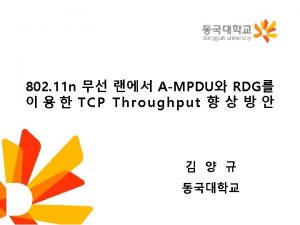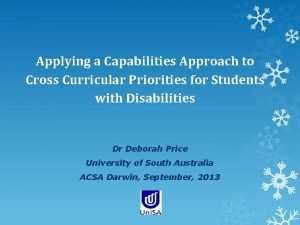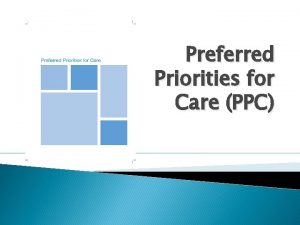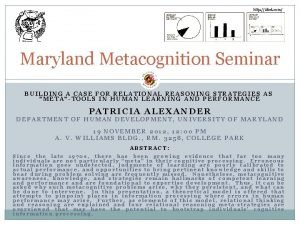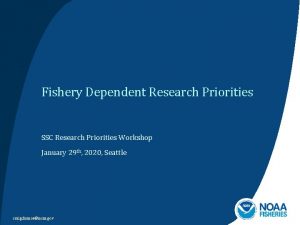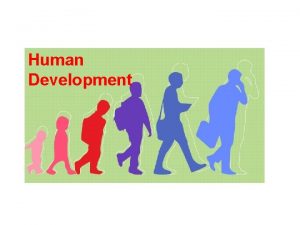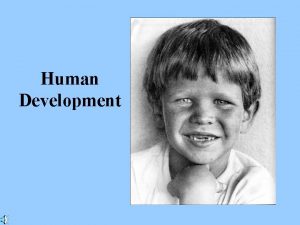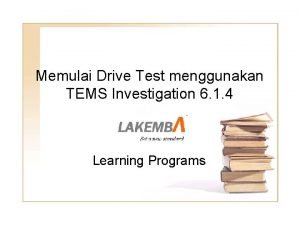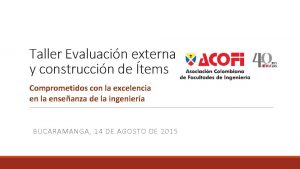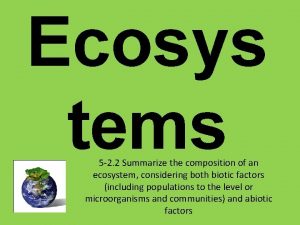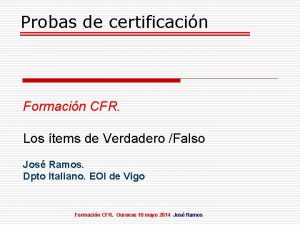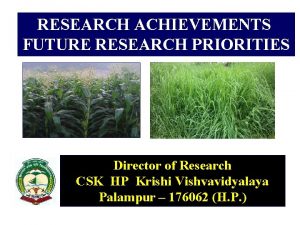The Alliance for Human Development Research Priorities TEMS




































- Slides: 36

The Alliance for Human Development Research Priorities TEMS, 2002 The evidence for investment in early childhood development for HEU children Stephen J. Lye Executive Director, Alliance for Human Development Scotia. Bank Scientist in Child and Adolescent Health and Development, Lunenfeld-Tanenbaum Research Institute Sinai Health System Professor of Ob/Gyn, Medicine and Physiology University of Toronto

The Alliance for Human Development Research Priorities I have no conflicts of Interest TEMS, 2002

The Alliance for Human Development Research Priorities A primary goal of all societies is to create environments where children can reach their full potential for health and well-being. This is important for ALL children, but some children are particularly vulnerable, including HEU children. . TEMS, 2002

The Alliance for Human Development Research Priorities TEMS, 2002 The Miracle of Human Development: establishing trajectories for life-long health and wellbeing A genetic blueprint in the embryo/fetus establishes the broad strokes of development Environment modifies this blueprint during critical periods of development

The Alliance for Human Development Research Priorities TEMS, 2002

The Alliance for Human Development Research Priorities TEMS, 2002 Early Environments and Human Development The Origins of Inequities in Health and Economic Achievement

The Alliance for Human Development Research Priorities Multiple Environments Impacting Child Development Nutrition / Health Social / Economic Physical Genetic Blueprint for Development Nurturing / protective TEMS, 2002

The Alliance for Human Development Research Priorities Nutrition / Health Physical Genetic Blueprint for Development Nurturing / protective Social / Economic TEMS, 2002 § Maternal health critical for successful pregnancy and fetal/infant development (mental health, anemia, immune function, nutrition) § Poor nutrition stunts brain growth § The developing brain requires calories, protein and lipids § Undernourished children have damaged systems to absorb nutrients

The Alliance for Human Development Research Priorities TEMS, 2002 Nutrition / Health Physical Genetic Blueprint for Development Nurturing / protective Social / Economic § Poverty major driver of developmental delay in children § SES drives disparities in health and education in childhood § SES in early childhood more impactful than SES in later life § Early stimulation is critical for later brain learning

The Alliance for Human Development Research Priorities Nutrition / Health Physical Genetic Blueprint for Development Nurturing / protective Social / Economic TEMS, 2002 § Brain development requires protective, caring environments § Poor parental mental health is associated with reduced learning and behavioural outcomes in children § Neglect fails to provide stimulation essential for brain function § Abuse results in elevated levels of cortisol which is toxic to brain cells

The Developing Brain Needs Nutrition, Stimulation and Protection Chugani et al Neuro. Image 14, 1290– 1301 (2001)

The Developing Brain Needs Nutrition, Stimulation and Protection Chugani et al Neuro. Image 14, 1290– 1301 (2001)

The Alliance for Human Development Research Priorities TEMS, 2002 Nutrition / Health Physical Genetic Blueprint for Development Nurturing / protective Social / Economic § Air pollution associated with poorer cognitive development in children – linked to breakdown of blood-brain barrier and brain inflammation § WASH § Climate change has greater impact on developing children

The Alliance for Human Development Research Priorities Risk of Poor Developmental Outcomes Increases with the Number and Duration of Adverse Exposures Nutrition / Health Social / Economic Physical Genetic Blueprint for Development Nurturing / protective TEMS, 2002

Supporting Child Development Healthy development needs nutrition, health, stimulation and protection (social and environmental). scienceofecd. com

The timing of exposures is critically important for development. scienceofecd. com

Sensitive Periods and The Developing Brain Cell division and migration Source: C. A. Nelson (2000). Credit: Center on the Developing Child

Building the Brain: Making the Neural Connections During late pregnancy the brain starts to wire itself forming connections called synapses In the months after birth over 1, 000 -10, 000 new connections (synapses) are made every second as the baby “senses” her environment. As baby’s gets a little older, their brains begin to eliminate rarely used pathways and to reinforce those that are used often, a process of refining and pruning the wiring of the brain.

Sensitive Periods and The Developing Brain Cell division and migration Source: C. A. Nelson (2000). Credit: Center on the Developing Child

The first 1000 days Pregnancy (9 mo = 270 days) + Year 1 (12 mo = 365 days) + Year 2 (12 mo = 365 days) = 1000 days

Life-course development The pregnancy environment impacts three generations (mother, child and grandchild) Foetal development Intergenerational effects Adult wellbeing & human capital Heightened susceptibility to harms and benefits Infant- child growth & development Adolescent education & wellbeing

The Alliance for Human Development Research Priorities The Preconception Environment (Father and Mother) Influence Child Development Health of the mother and father preconception influence the development of the fetus, infant and child Stress (PTSD) preconception impact behavior and anxiety in children Poor nutrition preconception impacts programming of metabolic function in children These effects must be mediated by epigenetic changes transmitted through egg and sperm TEMS, 2002

The Alliance for Human Development Research Priorities TEMS, 2002 The Pregnancy Environment and Developmental Programming During pregnancy and infancy the maternal environment plays a critical role in establishing developmental trajectories of the child Maternal Stressful exposures and poor mental health impact later behavior and anxiety in children Malnutrition impacts programming metabolic function in children of Fetus can hear early in pregnancy and respond to violence

The Alliance for Human Development Research Priorities Environments during Infancy and Developmental Programming Growth during infancy has a major impact on metabolic programming (obesity, diabetes) Breastfeeding critical for optimal growth, but also for bonding, immune function and establishment of the infant microbiome The child’s brain craves stimulation to form neuronal connections that underlie learning and memory. Neglect and abuse creates toxic stress and disrupts trajectories to behavior and learning TEMS, 2002

Alliance for Human Development, Research Priorities University of Toronto TEMS, 2002 Mechanisms Early-life exposures (first 1000 days) interact with the blueprint for development to set children on different trajectories that impact their life-long health, learning and behaviour. How?

Alliance for Human Development, Research Priorities University of Toronto TEMS, 2002 Mechanisms by which the Environment Impacts Child Development Environment Variations in Genetic Sequence Epigenetic Modification Adult Health and Wellbeing Cardiovascular disease Obesity/diabetes Mental health Cognitive function Behaviour/social function

Alliance for Human Development, Research Priorities University of Toronto TEMS, 2002 What are the outcomes of epigenetic changes? Preconception environments impact child development through epigenetic changes in egg and sperm Parenting behaviour impacts offspring stress responses associated with epigenetic changes in stress genes in child’s brain Maternal diet associated with epigenetic changes in offspring. Epigenetic changes in early life have been associated with obesity and cardiovascular disorders in childhood. M. Meaney, P. Mc. Gowan, M Szyf, K. Lillycrop, S. Ozanne, M. Vickers and many others

The Alliance for Human Development Research Priorities The Human Microbiome and Developmental Programming • Metabolism • Obesity and metabolic disease • Transfer of obese microbiomes • Brain endocrine stress axis • Postnatal microbial colonisation programmes brain stress responsiveness in mice • Immune Function • Link to inflammation TEMS, 2002

Alliance for Human Development Research Priorities TEMS, 2002 Dynamics and Stabilization of the Infant’s Microbiome Infancy • Breastfeeding major factor in defining infant gut microbiome • Influenced by short chain sugars in breast-milk • Infant microbiome produces essential amino acids, vitamins and iron metabolism (brain development) • Breast-feeding associated with an anti -inflammatory immune status in the child

Alliance for Human Development Research Priorities TEMS, 2002 Child Health and the Microbiome Malnutrition during pregnancy and infancy associated with abnormal (damaged? ) microbiome in children less able to process nutrients and micronutrients. An impaired microbiome reduces the effectiveness of nutritional interventions What is the impact of malnourished microbiome on child immune function and cognitive/social development? Gordon, JL and colleagues

Alliance for Human Development Research Priorities TEMS, 2002 Early-Life Exposures and Telomere Length • DNA-protein complexes that cap the ends of chromosomes, promote stability and prevent the degradation of chromosomes during cell division • Stressors cause accelerated telomere shortening and cellular senescence in cells. Shorter telomeres are also associated with diabetes, altered stress responses, susceptibility to infections and aging. • Early-life adversity associated with shorter telomere length in adulthood. • Telomere length is shorter in HIV+ individuals (including children) related to viral load, though limited data suggest that leukocyte telomere length not reduced in HEU, HEU exposed to ART – however, reduced telomere length in placenta of HIV+ pregnancies Chromosome Telomere Programmed cell death

The Alliance for Human Development Research Priorities TEMS, 2002 Multiple Genomes and Multiple Environments l a n r e t Ma Pat ern al Health Learning Child Mu ltip Genomes le En vir m n o ts n e Society Developmental Trajectories and Human Development

The Alliance for Human Development Research Priorities TEMS, 2002 Interventions to Promote Optimal Child Development u Recognize the complexity of exposures during development – requires multi-sectoral partnerships u Timed to Sensitive Periods u Sustained Across Early Childhood (and the life-course) u Based on Science u Recognize the needs of vulnerable populations Investing in the 1 st 1000 Days Of Life To Enable All Children, Everywhere To Reach Their Full Potential

The Alliance for Human Development Research Priorities Romania: Institutionalization Children fostered before 2 y achieved normal IQ in late childhood whereas children fostered after 2 y did not. Guatemala: Nutrition Children given a protein supplement before, but not after 2 y, had a 46% increase in adult wages (for men) Jamaica: Nutrition and Stimulation Children who received supplementary nutrition and home stimulation during the first 2 years achieved 24% higher wages as adults than controls Investing in the 1 st 1000 Days Of Life To Enable All Children, Everywhere To Reach Their Full Potential TEMS, 2002

The Alliance for Human Development Research Priorities Nurturing Care and HIV affected children • The benefits of nurturing care and early intervention applies to all HIV affected children • Cope with illness and stress, maintain their developmental trajectory • Includes HIV Exposed but Uninfected Children (HEU) • Exposed to the virus during pregnancy, delivery and breastfeeding, who do not become infected Investing in the 1 st 1000 Days Of Life To Enable All Children, Everywhere To Reach Their Full Potential TEMS, 2002

The Alliance for Human Development Research Priorities TEMS, 2002 Thank you! Promoting Early Child Development in HEU Children Advancing Early Childhood Development: from Science to Scale through Nurturing Care
 How to use tems investigation
How to use tems investigation Tems swp
Tems swp Tems drive test training
Tems drive test training Tems data collection
Tems data collection Tems tulane
Tems tulane Human needs and human development chapter 8
Human needs and human development chapter 8 Chapter 8 human needs and human development
Chapter 8 human needs and human development Gni definition ap human geography
Gni definition ap human geography Research alliance for new york city schools
Research alliance for new york city schools Lupus research alliance
Lupus research alliance Volkswagen of america: managing it priorities
Volkswagen of america: managing it priorities National co standards
National co standards Patrol base ops
Patrol base ops Bsa wilderness survival kit
Bsa wilderness survival kit Ggt 2030 applications
Ggt 2030 applications Defense priorities and allocations system
Defense priorities and allocations system Healthy vs unhealthy sibling relationships
Healthy vs unhealthy sibling relationships Core priorities
Core priorities Wood badge vision statement examples
Wood badge vision statement examples 6 quality priorities
6 quality priorities Core priorities
Core priorities Ampdu
Ampdu Cross curricular priorities
Cross curricular priorities Preferred priorities for care
Preferred priorities for care Goals and priorities
Goals and priorities Goals and priorities
Goals and priorities Goals and priorities
Goals and priorities Goals and priorities
Goals and priorities Priorities
Priorities Setting benchmarking priorities in logistics
Setting benchmarking priorities in logistics Thread priorities
Thread priorities Mixed priorities
Mixed priorities Www.xkcd.com
Www.xkcd.com Kontinuitetshantering
Kontinuitetshantering Typiska novell drag
Typiska novell drag Nationell inriktning för artificiell intelligens
Nationell inriktning för artificiell intelligens Returpilarna
Returpilarna





















